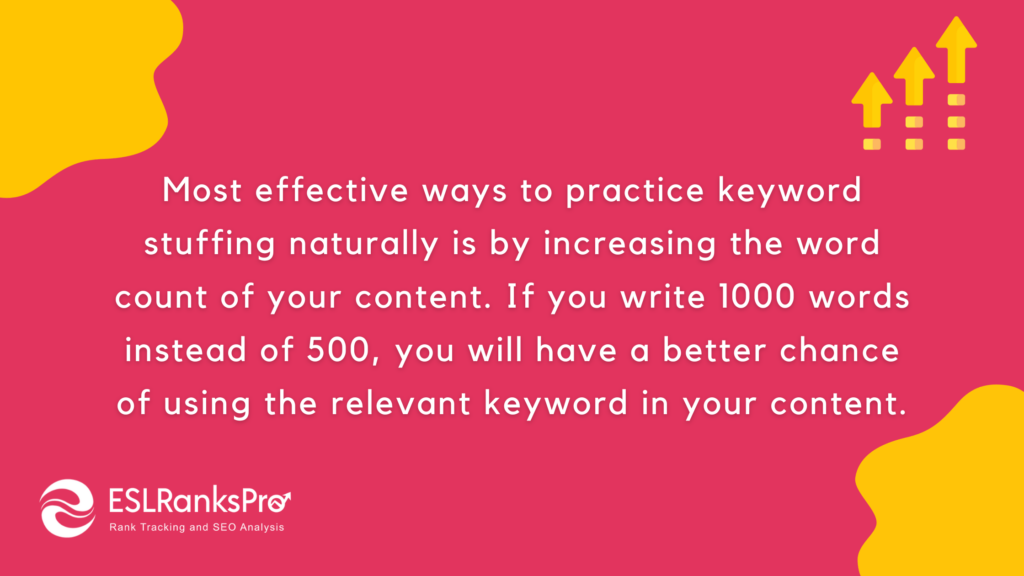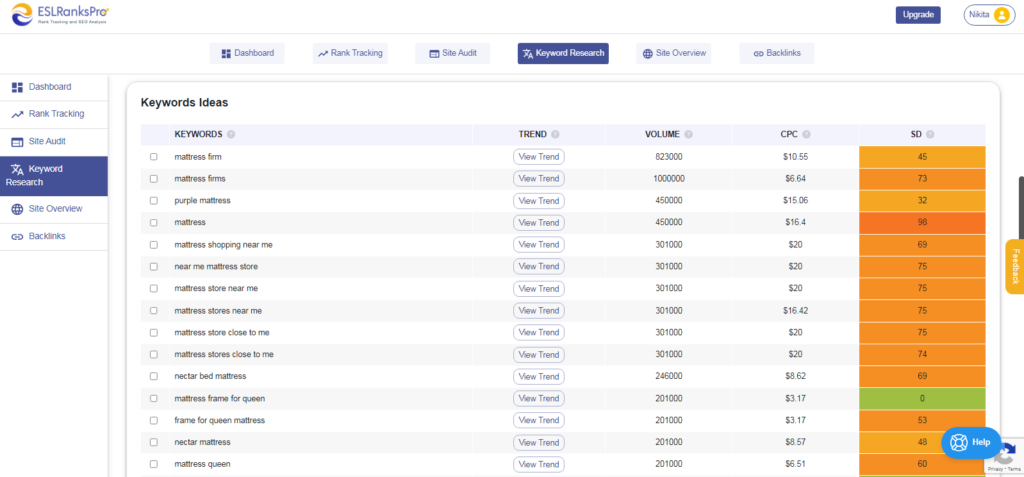In a competitive SEO world, people often get tempted to try all kinds of manipulation tactics to quickly get higher rankings. But ultimately, they do more harm to a business than good. Keyword stuffing is one of these manipulative techniques used to influence the ranking of a website with the intention of getting a higher rank on SERPs. Let’s discuss in detail keyword stuffing and its impact on the ranking and credibility of your website and your brand.

What is keyword stuffing?
According to Google Guidelines, keyword stuffing refers to the practice of filling a web page with keywords or numbers in an attempt to manipulate rankings in Google search results.
A decade ago, it was easy to manipulate Google’s SERP (search engine results page) and increase a web page’s visibility. However, search engines have become smarter now, and most importantly, they emphasize improving the user experience. On the contrary, keyword stuffing degrades the user experience.
Google has been introducing stringent ways to curb the manipulation of rankings. It can now penalise a website using tactics like keyword stuffing by demoting its ranking or simply deleting it from its index. Keyword stuffing is considered a spam technique and has also been listed in Google’s spam policies.

There are many ways to incorporate keyword stuffing into a given piece of content. These can be classified as visible keyword stuffing and invisible keyword stuffing.
What is visible keyword stuffing?
When you use a particular keyword or number repeatedly and out of context in a piece of content and your readers can see it, that’s visible keyword stuffing.

For example, let’s say a bathroom remodeler in San Diego is looking to get a web page quickly ranked high for the search term ‘bathroom remodelers in San Diego. In such a situation, an example of keyword stuffing in a web copy would be as follows:
Looking for bathroom remodelers in San Diego? You’ve come to the right place for the best bathroom remodeler in San Diego. We are the best bathroom remodelers in the city. Choose us when you are looking for the best bathroom remodeler in San Diego.
As you can see, the term ‘bathroom remodeler’ is used way too many times here. In many places, it has been used out of context. At the end, people will get frustrated with the overuse of a keyword in a piece of content.
Here’s another example of web page content where numerous closely related keywords is used to mislead the search engines. Now it’s not as obvious as the example above, but it’s still keyword stuffing.
Which is the best sofa fabric for your home? With so many choices, deciding on the best sofa fabric may prove to be a difficult task. The most commonly used sofa fabrics nowadays are linen, cotton, and wool.
Another way to use keyword stuffing is to use text blocks in content that just repeat a keyword.
In short, visible keyword stuffing includes the following:
- Repetitive use of keywords in a way that makes it obvious to the reader that it has been included to influence the rankings
- Adding lists of phone numbers without adding value
- Using text blocks that list the cities and areas a website is attempting to rank for.
What is invisible keyword stuffing?
Invisible keyword stuffing is a manipulative way to use a particular keyword or number repeatedly and out of context in a piece of content in such a way that users cannot see it.

There are numerous ways to hide keywords from readers; however, you cannot hide them from search engine crawlers.
Some content creators try to play it smart by making repetitive use of keywords without annoying the reader. They create spam, unreadable text and hide it from the reader. For instance, they make the color of the text and background the same, so users cannot recognize it.
However, the web page text, style, and size are still in HTML, so the search engine crawlers can spot them when they index your web page. Many times, people also stuff the keyword on the web. Here are some more examples of invisible keyword stuffing:
- Hiding” text with overloaded keywords by making them appear in the same color as the background color of a web page
- Hiding content by using a white font on a white background. While users may not be able to see it, search engine crawlers can identify it.
- Repetitive use of words and phrases in meta, comment, or alt tags or alt text
- Hiding repeated use of words in the code of your webpage
- Overstuffing or overusing words or phrases in your meta –tags and comment tags however search bots will still find them.
So, now you know the difference between Visible and Invisible Keyword stuffing. The picture given below will make it easier for you to understand it

Why is keyword stuffing considered a thing of the past?
Keyword stuffing has been used in the past to gain visibility and top rankings for specific phrases. However, this method is outdated now, and it adds no value to rankings.
As search engines evolved and updated their algorithms, keyword stuffing became a thing of the past and an outdated technique to gain visibility. Moreover, it is considered black hat SEO tactics that may put your brand reputation in trouble.
Your goal is to be liked by search engines to get better rankings, but Google dislikes black-hat tactics like keyword stuffing, as these methods focus on unethically gaining rankings rather than enhancing the user experience.
Google will penalise your site for keyword stuffing. In such a situation, your page could be demoted in rankings or even removed all together. Therefore, it is important to avoid keyword stuffing and instead focus on creating high-quality content that aligns with the user’s intent.
How does keyword stuffing adversely affect your website’s rankings?
Keyword stuffing can do more harm than good to your business. It can have a negative impact upon your website ranking and brand reputation in many ways:
User experience: When you use keyword stuffing in a content copy to gain more rankings, it means you are focusing more on ranking at the cost of user experience. On the other hand, search engines emphasise providing a positive customer journey and experience. If your site is identified for using unethical techniques like keyword stuffing, you could face penalties on the relevant pages or even on the site as a whole. In some situations, Google may even decide to remove your site entirely from SERPs (search engine results pages).
Loss of users. Users will eventually lose interest in the content aimed atincreasing rankings rather than informing and engaging with them. When people lose interest in content, it will have an impact on website traffic and ultimately have a negative impact on rankings.
Brand damage: If you keep on using tactics like keyword stuffing, it will make you lose your reputation. If people begin to associate your brand with poor content stuffed with repetitive words and phrases, it will ultimately lose credibility in the eyes of search engines as well as people.
What should you do instead of keyword stuffing to get better rankings?
Keyword stuffing may make your content appear unnatural and irrelevant to readers or website visitors. It has a negative impact on your website’s credibility as well as its ranking. However, you cannot deny the fact that ranking for the right keywords helps your site stand out from the crowd and get closer to the top of search engine results pages (SERPs).
So, what is the right way to use keywords to reach the top rankings? Below are some quick tips for the correct usage of the keywords.
Quick tips for the correct usage and frequency of keywords in the content
1. Finding relevant and valuable keywords
Effective keyword research is essential to finding the right keywords to include in the content before you can start stuffing them.

There is no use in adding low-value keywords to your content when you can use top-ranked keywords in your content ethically to perform better on SERPs. In order to find relevant and valuable keywords, focus on the following:
- Conduct effective keyword research to find relevant keywords.
- Use keyword research tools like ESL Ranks Pro, SEMRush, SpyFu, etc.
- Use long-tail keywords, as they are more specific and less competitive than short-tail keywords.
- You may also use secondary keywords, synonyms, or related long-tail phrases to help the search engine understand the context of your page.
2. Write for humans, not search engines.

Your content should be informative and engaging. Nowadays, search engines are much more focused on improving the user experience, so it is important to focus on quality as far as your content is concerned. The SEO keywords help you gain top ranking, but only when you are producing quality content. Once you are in the flow of creating content, the keywords will be added naturally.
- Produce engaging and informative content.
- Go with the flow, so keywords are added naturally.
- Learn about SEO copywriting to create valuable content.
3. Review and edit content.

When it comes to quality content, it should be well crafted to appeal to the reader. In your eagerness to add keywords with high Google keyword rankings, you may end up adding grammatically incorrect phrases and sentences to the content.
- Make sure the content is clear, coherent, and compelling.
- Review and proofread your content for spelling, grammar, punctuation, and readability errors.
- Use grammatical tools or professional editors to proofread the content before publishing.
4. Increase the word count.

One of the most effective ways to practice keyword stuffing naturally is by increasing the word count of your content. If you write 1000 words instead of 500, you will have a better chance of using the relevant keyword in your content.
However, be careful enough to keep the content informative and engaging. You must make sure that you are not adding stuff just to add keywords.
- Increase the word count of the content, but wisely.
- Write informative and engaging content.
- Provide value to the readers.
5. Check for inappropriate keyword density.
Keyword density is an SEO term that counts the number of times a search term (or “keyword”) is used on a web page. The density metric is usually reflected as a ratio of keywords used to the total word count of the content of a page. It can be calculated using a straightforward formula.
The number of times a keyword is used on your page should be divided by the total number of words on the page.
Suppose your page has 1,000 words and your keyword is used 100 times. This gives:
100 / 10000 =.001
Convert it into a percentage by multiplying it by 100, which in this case is 1%.The ideal keyword density is below 2%. So you can go ahead with 1% keyword density in the above example.
You can use keyword density checkers to make sure you stay below the ideal percentage. It can be helpful to use a keyword density checker to calculate the ideal number of keywords based on your text’s length.It will help make keywords sound natural. Thus, here are two important points to keep in mind:
- The ideal keyword density is up to 2%.
- Use a keyword density checker to keep keyword density low.
6. A primary keyword should be given to a single page
Conduct effective research to find a primary keyword for each web page and optimise your content accordingly. It should be closely related to the content of this page. Your content should cover that topic in full and support your primary keyword.
This makes it easier for search engines to understand what the content on each page is about, so they can better index it. It will also help to prevent keyword cannibalization.
- Choose a different primary keyword for each page.
- Use secondary keywords, keyword synonyms, and long-tail variations of the primary keyword within the content copy to reinforce the significance of the topic.
- If you are not sure what terms your targeted audience is using, you should use tools like ESL Ranks Pro, SEMRush, SpyFu, etc.

7. Use Keywords for On-Page SEO

One must use ethical SEO practices to gain higher rankings for a keyword. For instance, it is recommended to include keywords in the right sections of your web page such as
- Title Tag
- Meta Description
- Image alt tag
- First paragraph
- Page title
Your content body should be atleast 300 words otherwise, search engines may not be able to evaluate the quality of your content. Short post may be less valuable to potential readers, so it is usually recommended to include long form articles in your blog.
8. Vary your keyword placement

One of the effective ways to avoid keyword stuffing is to vary the placement of keywords in your web content. This indicates that you shouldn’t use the same keyword structure or position throughout your writing.
· Don’t use your keywords at the beginning of every phrase or paragraph.
· Place your keywords purposefully throughout your material, including the title, the introduction, the body, and the conclusion.
· Use synonyms and prevent repetition of words
9. Hire the experts
It requires knowledge and constant efforts to make your content rank higher on SERPS and it doesn’t happen overnight. SEO experts can help you to optimize for search intent for your specific target audience.

Conclusion
Keyword stuffing may seem like an attractive option to get higher rankings instantly. It is an outdated practice neither relevant and nor considered ethical SEO technique at all. It is in your best interest to avoid keyword stuffing which might lead to a penalty. I will also lower your content readability, negatively impact your site’s UX and increasing your bounce rate.
It is better to use ethical SEO practice such as finding relevant and valuable keywords, writing high quality content, using the right tools like ESL Ranks Pro to aid your search engine optimization journey. Hiring SEO experts is your best bet to get SEO performed in an ethical way, while making sure it works for your business.
Keywords are the most important ingredient of an SEO strategy. Missing something in your keyword research can be a costly affair. ESL Rank Pro makes it easy for you to get detailed and accurate insight into any keyword research along with keyword difficulty, search volume and other metrics. Discover high performing keyword with low difficulty easily and quickly. Start competitive keyword analysis today.




